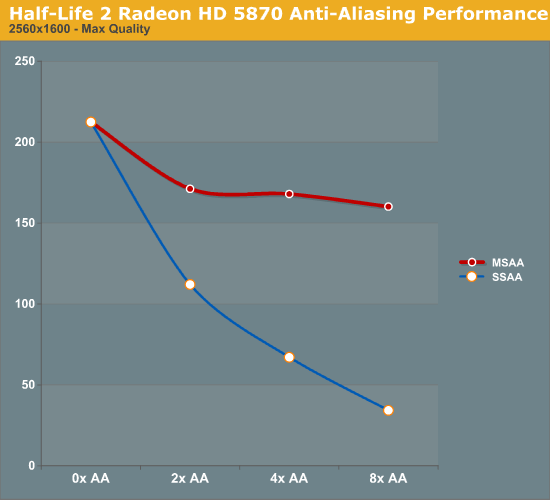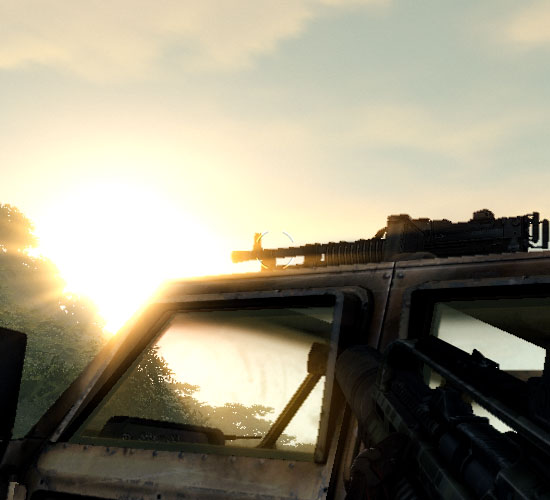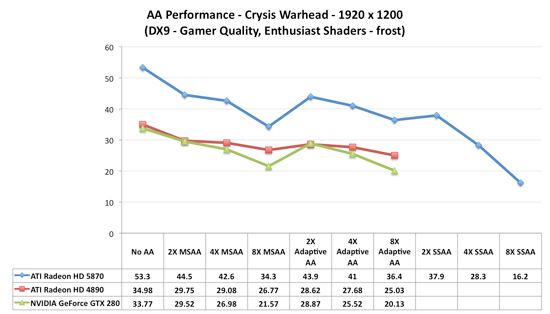AMD's Radeon HD 5870: Bringing About the Next Generation Of GPUs
by Ryan Smith on September 23, 2009 9:00 AM EST- Posted in
- GPUs
AA Image Quality & Performance
With HL2 unsuitable for use in assessing image quality, we will be using Crysis: Warhead for the task. Warhead has a great deal of foliage in parts of the game which creates an immense amount of aliasing, and along with the geometry of local objects forms a good test for anti-aliasing quality. Look in particular at the leaves both to the left and through the windshield, along with aliasing along the frame, windows, and mirror of the vehicle. We’d also like to note that since AMD’s SSAA modes do not work in DX10, this is done in DX9 mode instead.
|
AMD Radeon HD 5870
|
AMD Radeon HD 4870
|
NVIDIA GTX 280
|
| No AA | ||
| 2X MSAA | ||
| 4X MSAA | ||
| 8X MSAA | ||
| 2X MSAA +AAA | 2X MSAA +AAA | 2X MSAA + SSTr |
| 4X MSAA +AAA | 4X MSAA +AAA | 4X MSAA + SSTr |
| 8X MSAA +AAA | 8X MSAA +AAA | 8X MSAA + SSTr |
| 2X SSAA | ||
| 4X SSAA | ||
| 8X SSAA |
From an image quality perspective, very little has changed for AMD compared to the 4890. With MSAA and AAA modes enabled the quality is virtually identical. And while things are not identical when flipping between vendors (for whatever reason the sky brightness differs), the resulting image quality is still basically the same.
For AMD, the downside to this IQ test is that SSAA fails to break away from MSAA + AAA. We’ve previously established that SSAA is a superior (albeit brute force) method of anti-aliasing, but we have been unable to find any scene in any game that succinctly proves it. Shader aliasing should be the biggest difference, but in practice we can’t find any such aliasing in a DX9 game that would be obvious. Nor is Crysis Warhead benefitting from the extra texture sampling here.
From our testing, we’re left with the impression that for a MSAA + AAA (or MSAA + SSTr for NVIDIA) is just as good as SSAA for all practical purposes. Much as with the anisotropic filtering situation we know through technological proof that there is better method, but it just isn’t making a noticeable difference here. If nothing else this is good from a performance standpoint, as MSAA + AAA is not nearly as hard on performance as outright SSAA is. Perhaps SSAA is better suited for older games, particularly those locked at lower resolutions?
For our performance data, we have two cases. We will first look at HL2 on only the 5870, which we ran before realizing the quality problem with Source-engine games. We believe that the performance data is still correct in spite of the visual bug, and while we’re not going to use it as our only data, we will use it as an example of AA performance in an older title.

As a testament to the rendering power of the 5870, even at 2560x1600 and 8x SSAA, we still get a just-playable framerate on HL2. To put things in perspective, with 8x SSAA the game is being rendered at approximately 32MP, well over the size of even the largest possible single-card Eyefinity display.
Our second, larger performance test is Crysis: Warhead. Here we are testing the game on DX9 mode again at a resolution of 1920x1200. Since this is a look at the impact of AA on various architectures, we will limit this test to the 5870, the GTX 280, and the Radeon HD 4890. Our interest here is in performance relative to no anti-aliasing, and whether different architectures lose the same amount of performance or not.
Starting with the 5870, moving from 0x AA to 4x MSAA only incurs a 20% drop in performance, while 8x MSAA increases that drop to 35%, or 80% of the 4x MSAA performance. Interestingly, in spite of the heavy foliage in the scene, Adaptive AA has virtually no performance hit over regular MSAA, coming in at virtually the same results. SSAA is of course the big loser here, quickly dropping to unplayable levels. As we discussed earlier, the quality of SSAA is no better than MSAA + AAA here.
Moving on, we have the 4890. While the overall performance is lower, interestingly enough the drop in performance from MSAA is not quite as much, at only 17% for 4x MSAA and 25% for 8x MSAA. This makes the performance of 8x MSAA relative to 4x MSAA 92%. Once again the performance hit from enabling AAA is miniscule, at roughly 1 FPS.
Finally we have the GTX 280. The drop in performance here is in line with that of the 5870; 20% for 4x MSAA, 36% for 8x MSAA, with 8x MSAA offering 80% of the performance. Even enabling supersample transparency AA only knocks off 1 FPS, just like AAA under the 5870.
What this leaves us with are very curious results. On a percentage basis the 5870 is no better than the GTX 280, which isn’t an irrational thing to see, but it does worse than the 4890. At this point we don’t have a good explanation for the difference; perhaps it’s a product of early drivers or the early BIOS? It’s something that we’ll need to investigate at a later date.
Wrapping things up, as we discussed earlier AMD has been pitching the idea of better 8x MSAA performance in the 5870 compared to the 4800 series due to the extra cache. Although from a practical perspective we’re not sold on the idea that 8x MSAA is a big enough improvement to justify any performance hit, we can put to rest the idea that the 5870 is any better at 8x MSAA than prior cards. At least in Crysis: Warhead, we’re not seeing it.












327 Comments
View All Comments
ilnot1 - Wednesday, September 23, 2009 - link
In fact, going by the lowest Newegg prices, this is how the top setups would stack up today:5870 CF .......= $760
GTX 285 SLI .= $592
GTX 295 .......= $470
GTX 275 SLI .= $420
5870 ............= $380
4890 CF ........= $360
4870 X2 ........= $330
This would make the 4890 CF or the 275 SLI setups the best value. And yes I realize there will be availability issues and price adjustments over the next month or so.
DominionSeraph - Thursday, September 24, 2009 - link
you forgot:4870 CF: $260-280
and how about the $180 4850 CF, which is probably the best price/performance for sub-1920x1200 gaming. http://www.anandtech.com/video/showdoc.aspx?i=3517...">http://www.anandtech.com/video/showdoc.aspx?i=3517... You can even get 1GB versions for ~$190.
ilnot1 - Wednesday, September 23, 2009 - link
Another very good review, thanks.But piggy backing on what wicko said, I'm surprised you didn't include two 4890 in CF. Seeing as how you can get two 4890 for less than a 5870 (whenever they are actually available). $180 x 2 = $360 < $379. And this from Newegg, not some super special sale price.
http://www.newegg.com/Product/Product.aspx?Item=N8...">http://www.newegg.com/Product/Product.aspx?Item=N8...
Ryan Smith - Wednesday, September 23, 2009 - link
It's something we would have included if we had the cards. I don't have 2 4890s, and we couldn't get a second one in time.AnotherGuy - Wednesday, September 23, 2009 - link
as always anandtech roxnbjsl2000 - Wednesday, September 23, 2009 - link
Finally time to upgrade..SiliconDoc - Wednesday, September 23, 2009 - link
Not only all that, but when there were 13 big titles for PhysX and a hundred smaller ones, we were told here, "Meh", who needs it.Now, we have a papery and unavailable (egg)except by pre-order(tiger) 5870 launch, a not-existing 5850, with guess what ? NO DX11 games!
Oh wait, there is actually just ONE - see page 7 of review. LOL
---
Conclusion ?: " It looks like NO(err.. just one) DX11 games ready, so... it also looks like NVidia is launching at the right time, and ATI blew their dry unimpressive wad on a piece of paper porn. "
---
Gee no one crowing about the first DX11 card... imagine that...
Good thing , too, considering how 13 big or a hundred titles small of PhysX enhanced games was "nothing to change one's purchase decision over". At least Anand got addicted to Mirror's Edge with PhysX enabled before concluding in the article "meh" this PhysX thing is ok if you like this game, but who cares...
---
Now we have the DX11 pre DX11 games launch with a paper product, so crowing about it wouldn't be too fitting, huh.
monomer - Wednesday, September 23, 2009 - link
Why would a developer would release a DX11 game before DX11 is even available?SiliconDoc - Friday, September 25, 2009 - link
Why would a developer release a DX11 card before DX11 is even available ?(I suppose you'll have to unscrew your hate nvidia foil cap, and grind in the red spikes in it's place to answer that one.)
However, allow me, instead.
1.I have been running windows 7 32&64 for quite some time now, not sure why you haven't been.
2. Battleforge, an ATI promo game, as noted in the review, has released their DX11 patch, hence, with W7 from MSFT (the beta+ free trial good till March 1st 2010 or something like that) I believe any gamer has had a reasonable chance to preview DX11.
---
So anyway...
cactusdog - Friday, September 25, 2009 - link
Ya , ATI has done it again. Excellent performance for a fair price. If Nvidia released this exact card it would be $150-$200 more expensive.LOL, Nvidia sales are gonna be slow for a while.